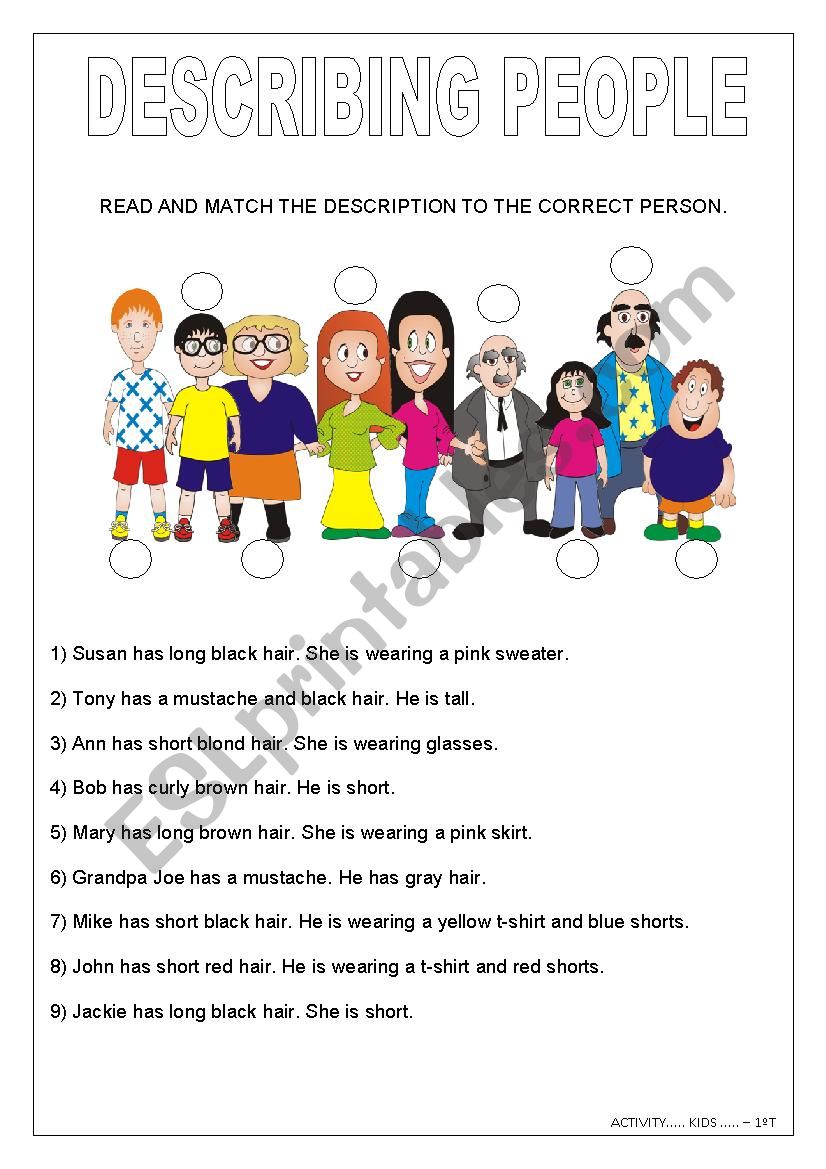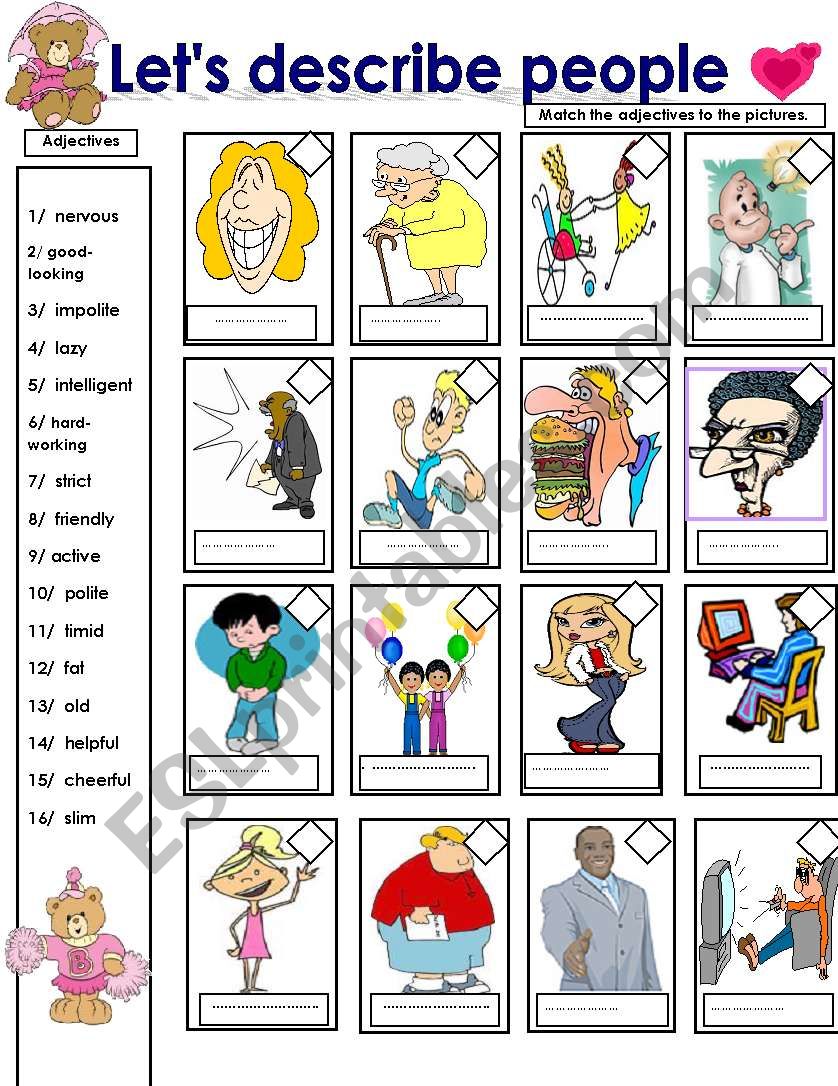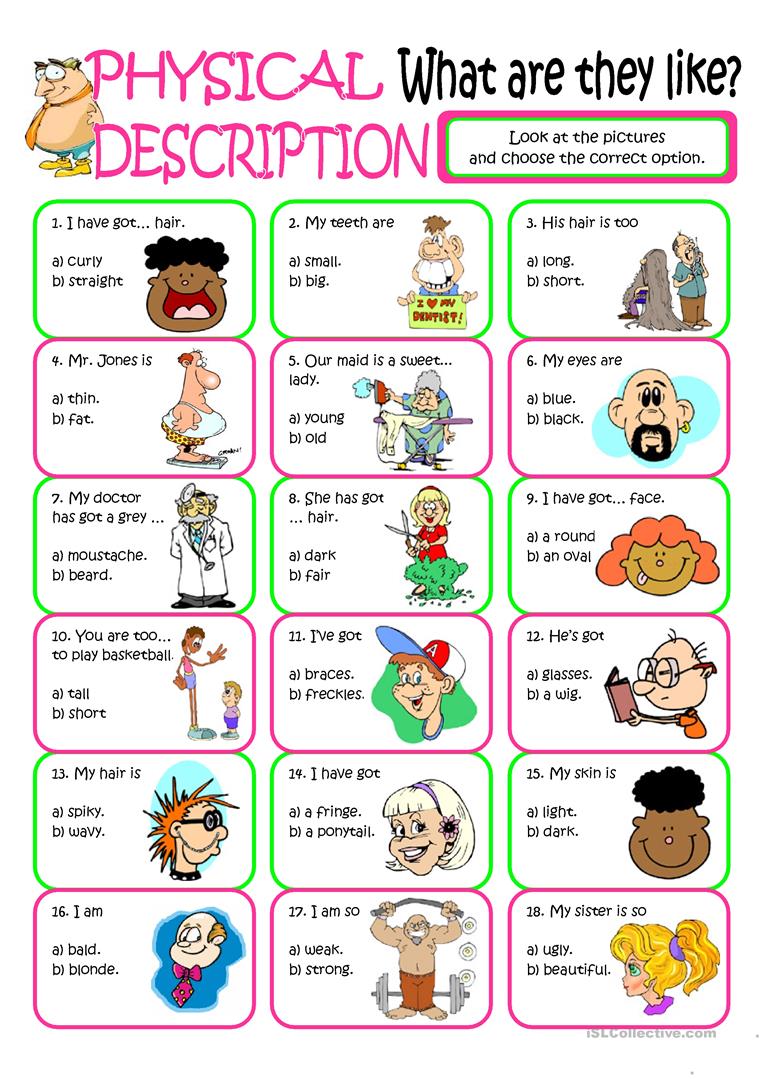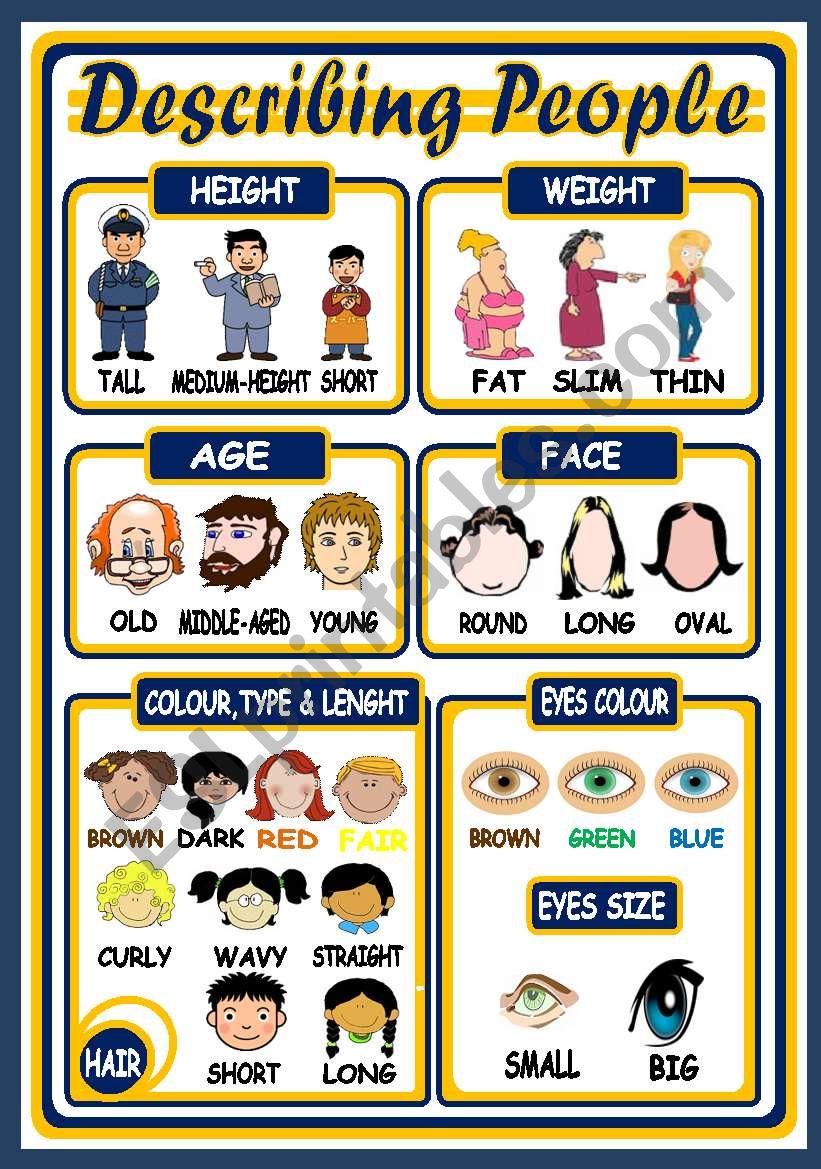
Mastering the Art of Description: The Power of Describing People Worksheets
In the intricate tapestry of human communication, the ability to describe people effectively stands out as a fundamental skill. Whether for identifying an individual, recounting an event, creating vivid characters in a story, or simply engaging in everyday conversation, accurate and nuanced descriptions are invaluable. For language learners, mastering this skill is crucial for achieving fluency and confidence. This is where describing people worksheets emerge as an indispensable tool, providing structured practice and a systematic approach to acquiring the necessary vocabulary, grammar, and observational skills.
This comprehensive article will delve into the profound importance of describing people, explore the various components and types of describing people worksheets, highlight their immense benefits for both learners and educators, and offer strategies for their most effective utilization.
The Significance of Describing People

Before we dive into the worksheets themselves, it’s vital to understand why describing people is such a cornerstone of language proficiency:

- Effective Communication: In daily life, we constantly need to describe people. From telling a friend about a new colleague to reporting a lost child, clear descriptions ensure information is accurately conveyed and understood.
- Narrative and Storytelling: Authors, screenwriters, and even casual storytellers rely heavily on descriptive language to bring characters to life, making them relatable, memorable, and integral to the narrative. Without strong descriptions, characters remain flat and unengaging.
- Observation and Critical Thinking: The act of describing forces learners to pay close attention to details – physical appearance, mannerisms, expressions, and clothing. This hones their observational skills, a valuable asset extending far beyond language learning.
- Vocabulary Expansion: Describing people necessitates a rich vocabulary of adjectives, adverbs, nouns, and verbs related to appearance, personality, emotions, and actions.
- Grammar Reinforcement: It provides practical application for various grammatical structures, including the use of adjectives, adverbs, comparative and superlative forms, prepositions of place, and the verb "to be."
- Social Interaction: Understanding how to describe others respectfully and appropriately is a key component of social etiquette and cross-cultural communication.




What Are Describing People Worksheets?
At their core, describing people worksheets are structured educational materials designed to help individuals, particularly language learners, practice and improve their ability to describe people accurately and vividly. They transform the abstract concept of description into tangible, manageable exercises. These worksheets typically focus on:

- Vocabulary Acquisition: Introducing and reinforcing words related to physical characteristics (e.g., tall, short, plump, slim, blonde, curly, scar, wrinkle), personality traits (e.g., kind, shy, outgoing, arrogant, humble), clothing (e.g., casual, formal, trendy, elegant), and accessories.
- Grammar Application: Providing contexts to practice the correct use of adjectives, adverbs, the verb "to be," prepositions (e.g., "wearing a hat on her head," "a mole on his cheek"), and various sentence structures.
- Observational Skills: Often incorporating images or scenarios that require learners to scrutinize details before formulating their descriptions.
- Creative Expression: Encouraging learners to move beyond simple lists and craft more detailed, imaginative, and cohesive descriptions.


Key Components and Vocabulary Categories
Effective describing people worksheets break down the complex task of description into manageable categories. Here are the common components and vocabulary areas they address:
-
Physical Appearance:
- General Build/Shape: Tall, short, medium height, slender, slim, thin, skinny, average build, well-built, muscular, plump, overweight, obese, curvy.
- Hair: Long, short, medium-length, straight, curly, wavy, spiky, bald; blonde, brunette, redhead, black, grey, white, dyed.
- Face: Round, oval, square, heart-shaped, long, narrow; freckled, pale, tanned, wrinkled, smooth complexion.
- Eyes: Big, small, almond-shaped, round; blue, brown, green, hazel; bright, sparkling, piercing, tired.
- Nose: Small, large, straight, hooked, upturned.
- Mouth/Lips: Full, thin, wide, narrow; smiling, frowning.
- Distinguishing Features: Beard, mustache, glasses, dimples, scars, tattoos, piercings, moles, birthmarks.
-
Personality Traits (Character/Temperament):
- Positive: Kind, generous, brave, honest, loyal, intelligent, humorous, patient, optimistic, ambitious, hardworking, reliable, compassionate, adventurous.
- Negative: Rude, selfish, arrogant, lazy, dishonest, impatient, pessimistic, jealous, manipulative, aggressive.
- Neutral/Descriptive: Reserved, quiet, talkative, introverted, extroverted, moody, shy, confident.
-
Clothing and Style:
- Types of clothing: Jeans, trousers, skirt, dress, shirt, blouse, jacket, coat, sweater, hoodie.
- Style: Casual, formal, smart, trendy, elegant, classic, sporty, bohemian, scruffy.
- Colors, patterns, materials: Red, blue, striped, floral, denim, cotton, silk.
-
Mannerisms and Behavior:
- Gestures: Waving, nodding, shrugging, fidgeting.
- Posture: Upright, slouching, leaning.
- Way of speaking: Soft-spoken, loud, articulate, mumbling, fast, slow.
- Expressions: Smiling, frowning, laughing, serious, thoughtful.
Types of Describing People Worksheets
The variety of describing people worksheets is vast, catering to different learning styles and proficiency levels. Here are some common types:
-
Vocabulary Matching/Fill-in-the-Blanks:
- Purpose: Basic vocabulary acquisition and reinforcement.
- Example: Match adjectives (e.g., "curly") to nouns (e.g., "hair") or fill in blanks in sentences ("She has long, __ hair.").
-
Picture Description:
- Purpose: Practicing observation and applying vocabulary to visual cues.
- Example: Students are given a picture of a person and asked to describe their appearance, clothing, and possibly their perceived mood or activity. These can range from simple (describe 3 things) to complex (write a detailed paragraph).
-
"Guess Who?" / Mystery Person:
- Purpose: Engaging deductive reasoning and practicing question formation and descriptive answers.
- Example: One student describes a hidden character (from a set of pictures) while others ask yes/no questions (e.g., "Does he have glasses? Is she wearing a hat?").
-
Character Profile Creation:
- Purpose: Encouraging creative writing and deeper character development.
- Example: Students are given prompts (e.g., "Create a character for a story") and asked to describe their appearance, personality, background, and quirks.
-
"Spot the Difference" / Comparative Description:
- Purpose: Highlighting specific details and practicing comparative language.
- Example: Two slightly different pictures of people are shown, and students describe the differences (e.g., "Person A has short hair, but Person B has long hair.").
-
Role-Playing and Interviews:
- Purpose: Practicing real-time communication and spontaneous description.
- Example: One student acts as a police sketch artist, and another describes a "suspect." Or students "interview" each other and describe their partner to the class.
-
Error Correction/Sentence Transformation:
- Purpose: Reinforcing grammar rules and accurate word choice.
- Example: Students correct grammatically incorrect descriptions or rewrite simple sentences into more complex, descriptive ones.
-
Listening and Drawing:
- Purpose: Developing listening comprehension and the ability to translate auditory information into visual representation.
- Example: The teacher describes a person, and students draw what they hear. Then they compare their drawings to the original image or description.
Benefits for Learners and Educators
The multifaceted benefits that describing people worksheets offer extend to both those learning and those teaching:
For Learners:
- Systematic Vocabulary Building: Worksheets provide a structured way to learn and categorize descriptive adjectives, nouns, and verbs.
- Grammar Reinforcement: They offer practical application for grammatical concepts (e.g., adjective order, verb "to be" usage, prepositions).
- Improved Observation Skills: By focusing on visual details, learners train their eyes to notice nuances.
- Enhanced Communication Skills: Practicing descriptions improves both written and oral fluency, clarity, and precision.
- Increased Confidence: Successfully completing tasks related to description builds confidence in using the target language.
- Preparation for Real-Life Scenarios: From casual conversations to formal reports, the skill of description is universally applicable.
For Educators:
- Versatility and Adaptability: Worksheets can be easily adapted for various proficiency levels, from beginner to advanced.
- Engaging Activities: Many types of worksheets (e.g., "Guess Who?") are inherently fun and interactive, increasing student engagement.
- Differentiated Instruction: Educators can select or modify worksheets to cater to diverse learning needs within a single classroom.
- Assessment Tools: Worksheets serve as excellent formative and summative assessment tools to gauge students’ progress in vocabulary, grammar, and descriptive ability.
- Time-Saving Resources: Ready-made worksheets save preparation time, allowing teachers to focus on instruction and interaction.
- Scaffolding: They provide necessary scaffolding for learners, breaking down complex tasks into manageable steps.
Effective Strategies for Utilizing Describing People Worksheets
To maximize the impact of describing people worksheets, educators and learners should consider the following strategies:
- Pre-teach and Review Vocabulary: Before diving into a worksheet, introduce or review relevant vocabulary. Use flashcards, visual aids, and realia.
- Model Good Descriptions: Demonstrate what a good description looks like. Provide examples that are detailed, organized, and use varied language.
- Encourage Observation: Train students to look beyond the obvious. Ask guiding questions like, "What about their eyes? What kind of clothes are they wearing? Do they look happy or sad?"
- Vary Activities: Don’t stick to just one type of worksheet. Mix matching exercises with picture descriptions, role-plays, and creative writing prompts to keep things fresh and target different skills.
- Promote Peer Interaction: Encourage students to work in pairs or small groups. Peer-to-peer description and feedback can be incredibly effective.
- Connect to Real Life: Use pictures of famous people, characters from movies, or even (respectfully) classmates. Ask students to describe people they know or have seen.
- Provide Constructive Feedback: Focus on clarity, accuracy, and richness of description. Point out areas for improvement in vocabulary or grammar without discouraging.
- Integrate with Other Skills:
- Listening: Describe a person orally and have students draw them or choose from multiple pictures.
- Speaking: Have students present their descriptions to the class or engage in "show and tell" with pictures.
- Writing: Assign longer descriptive paragraphs or short stories incorporating described characters.
Conclusion
The ability to describe people is a vibrant thread woven throughout the fabric of effective communication. For language learners, it’s not merely about memorizing adjectives but about developing a keen eye, a rich vocabulary, and the grammatical prowess to articulate observations. Describing people worksheets are the unsung heroes in this journey, offering a structured, engaging, and highly effective pathway to mastering this essential skill.
From basic vocabulary drills to complex character profiles, these worksheets provide the scaffolding and practice necessary to transform hesitant learners into confident communicators capable of painting vivid word pictures. By embracing and strategically utilizing the diverse range of describing people worksheets, educators can empower their students to articulate the world around them with precision, creativity, and profound clarity, truly mastering the art of description.
